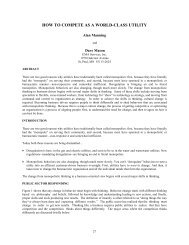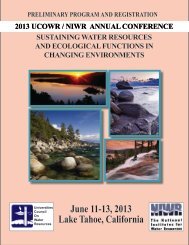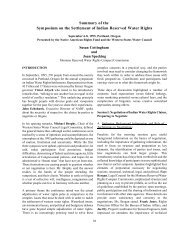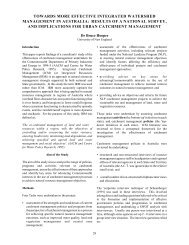Full Journal of Contemporary Water Research and Education, Issue ...
Full Journal of Contemporary Water Research and Education, Issue ...
Full Journal of Contemporary Water Research and Education, Issue ...
You also want an ePaper? Increase the reach of your titles
YUMPU automatically turns print PDFs into web optimized ePapers that Google loves.
1UNIVERSITIES COUNCIL ON WATER RESOURCESJOURNAL OF CONTEMPORARY WATER RESEARCH & EDUCATIONISSUE 135, PAGES 1-7 DECEMBER 2006Integrated <strong>Water</strong> Resources Management:Governance, Best Practice, <strong>and</strong> <strong>Research</strong> ChallengesBruce HooperDHI <strong>Water</strong> <strong>and</strong> Environment, Brisbane, AustraliaThis collection <strong>of</strong> invited papers published inthis issue <strong>of</strong> the <strong>Journal</strong> <strong>of</strong> <strong>Contemporary</strong><strong>Water</strong> <strong>Research</strong> <strong>and</strong> <strong>Education</strong> examinesthe theme <strong>of</strong> governance in integrated waterresources management (IWRM). Governance isa suite <strong>of</strong> procedures that use decision-makingprocesses at different levels <strong>and</strong> among differentsectors, stakeholders, <strong>and</strong> jurisdictions to enact,in this case, water resources management. Muchhas been said about governance in the water sector,with one foundational explanation provided by theGlobal <strong>Water</strong> Partnership (undated):• Governments to establish water policies, laws<strong>and</strong> regulatory frameworks, devolve decisionmaking,<strong>and</strong> encourage better service deliveryby autonomous public sector agencies <strong>and</strong>private sector operators.• Governments to set policies <strong>and</strong> establishinstitutional structures for managing riverbasins <strong>and</strong> aquifers <strong>and</strong> processes to overcomeconflict over water allocation.• Governments to facilitate the realignment <strong>of</strong>economic <strong>and</strong> financial practices, includingfull cost pricing for water services—withappropriate mechanisms to protect the poor.• Governments, with the help <strong>of</strong> internationalpartners, to establish mechanisms forstrengthening river basin management <strong>and</strong>establishing transboundary water agreementsallowing for equitable utilization <strong>of</strong> sharedwaters.This functionality emphasizes the role <strong>of</strong> thepublic sector <strong>and</strong> sees governance comprising thecore elements <strong>of</strong> water policy, water laws, waterpricing mechanisms, river basin organizations <strong>and</strong>international <strong>and</strong> intra-national (cross-jurisdiction,cross-boundary) agreements. These elements do notexist in an institutional vacuum, rather they relateto the broader democratic functions <strong>of</strong> government<strong>and</strong> civil society. Indeed, good governance occurswhen societies establish democratic freedoms (freeelections), robust economies, low unemployment,state-<strong>of</strong>-the-art technological development, financial<strong>and</strong> resource security, human rights, <strong>and</strong> lack<strong>of</strong> civil unrest. Poverty, insurgence <strong>and</strong> nationalsecurity work against good governance <strong>and</strong> the wayto implement IWRM in struggling economies willrequire the simultaneous elimination <strong>of</strong> civil unrest<strong>and</strong> poverty. These form the precursor to effectivewater governance. This expansive governancem<strong>and</strong>ate, more than one focusing solely on thewater sector, suggests a number <strong>of</strong> elements arerequired: transparency, accountability, anticorruption,citizen participation, <strong>and</strong> a workingjudiciary.<strong>Issue</strong> OutlineThe papers are grouped into two themes:concepts <strong>and</strong> practices. The first theme comprisesfour papers that discuss the conceptual complexity<strong>of</strong> IWRM <strong>and</strong> its expression in emerging waterpolicies. In a refreshing exploratory discussion,Cardwell et al. present an innovative framework,using the axes <strong>of</strong> time, space, institutions, <strong>and</strong>objectives, for examining the nature <strong>and</strong> degree <strong>of</strong>management integration relevant to water resourcesmanagement, comparing this with both U.S. <strong>and</strong>international IWRM conceptualizations. Theymaintain the need for spatial, objective (goals),JOURNAL OF CONTEMPORARY WATER RESEARCH & EDUCATIONUCOWR








